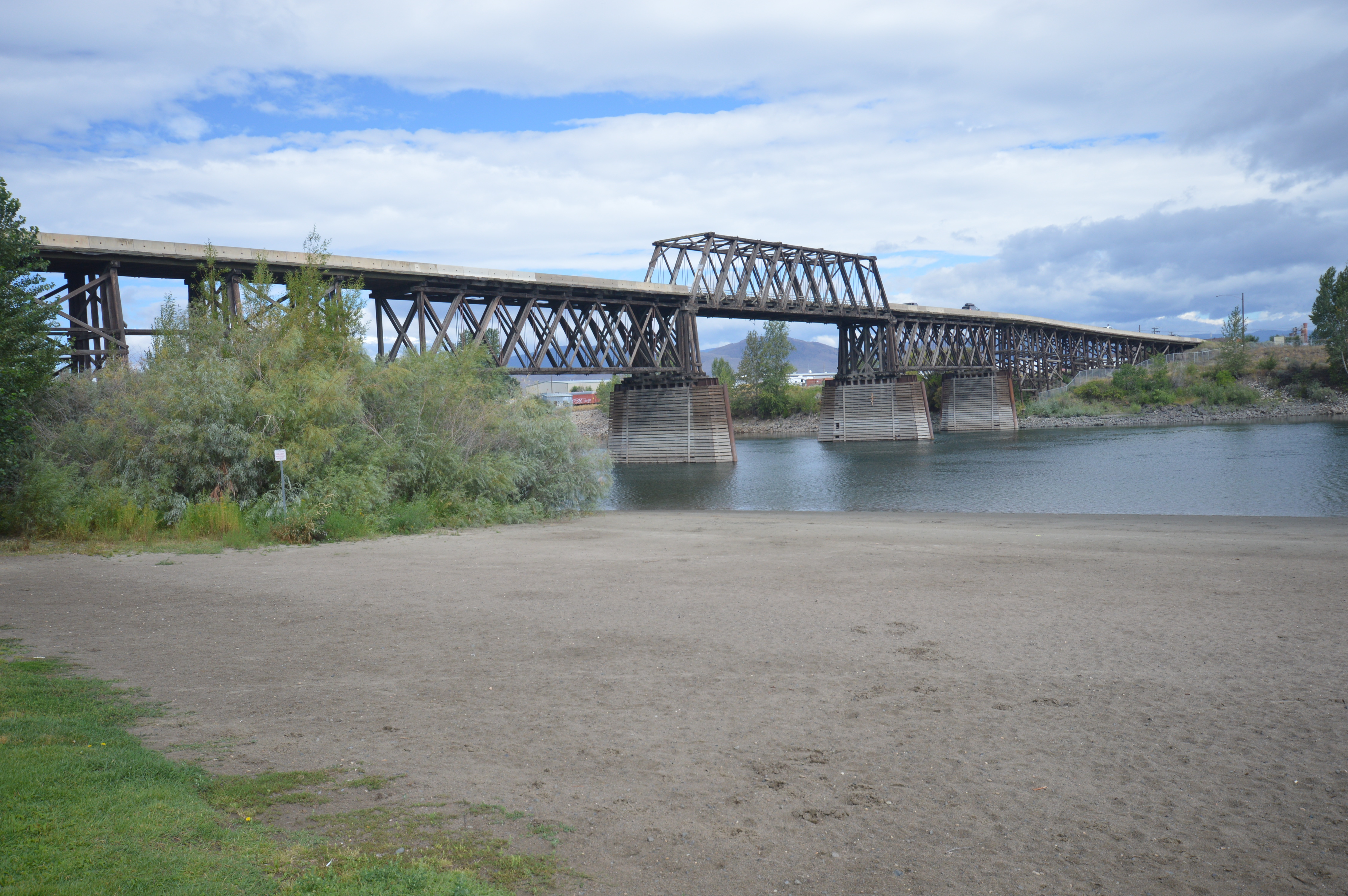The Red Bridge is a wooden Howe truss road bridge built in 1936 that spans the South Thompson River and connects the City of Kamloops to the Tk'emlúps Indian Band's Reserve and industrial park. It also provides an alternative access to the Yellowhead Highway and North Thompson District.
Heritage Values
The Kamloops Red Bridge is significant for its historical, cultural and economic values.
The current bridge is the third wooden truss bridge located at this site and is valued as a symbol of the evolution and continued use of this location as a key crossing point on the South Thompson River. The first bridge was built in 1887 and named the Government Bridge but colloquially called the Red Bridge. The importance of the bridge as a transportation route is evident in that new bridges were built on the same location in 1912 and again in 1936. On the 2012 Kamloops Bi-Centennial the bridges served to connect Kamloops to the Tk'emlúps Indian Band Reserve and pioneer farming and ranching settlements along the North Thompson River for 125 years.
From 1887 the bridges were an important link between two cultures, the Tk'emlúps Indian Band on the north shore and the predominately white population in the city. The Red Bridges also reflect local transportation history from the era of horse and wagon transport to automobile traffic. The third Red Bridge remains an important tie between two economic systems with Kamloops' major industrial area being located on leased Reserve Land with the bridge being the main connection to the downtown commercial area.
The location of the bridge is a natural crossing point on the South Thompson River before it joins the North Thompson River. For thousands of years the Tk'emlúps Indian Band of the Secwépemc Nation lived in the area as hunters and gatherers. They were nomadic during the summer relying on salmon from the river, wild game, and nature's provisions. In the winter they lived in Keekwillie pit houses along the shores of the South Thompson and Thompson rivers. Archaeological evidence of pit houses, burial sites and artifacts remain abundant to the present and can be viewed at the Secwépemc Museum and Heritage Park.
The bridge is centrally located and provides views of Mount Paul, Mount Peter and the conjunction of the South Thompson and North Thompson Rivers. From the sidewalk deck, views of the federal designated heritage Canadian National Railway station built in 1927, Riverside Park established in 1905, the Indian Residential School opened in 1890 and Pioneer Park all contribute to its heritage character.
Character Defining Elements
Key character defining elements of the Kamloops Red Bridge include its:
September 19, 2024 Fire
“On Thursday Sept. 19, 2024, around 3:25 a.m., Kamloops and Tk’emlúps Rural RCMP Detachment frontline officers were called to assist Kamloops Fire and Rescue at the Red Bridge, which was fully engulfed by flames,” said the RCMP in a statement. “While fire responders battled the blaze, the bridge collapsed and was sadly completely destroyed.”
Source: Radio NL News Article
Site:
- scenic views of Mount Paul and Mount Peter
- located near conjunction of South Thompson and North Thompson Rivers
- heritage views of Riverside Park (1905), Pioneer Park, Canadian National Railway station (1927), Canadian National Railway Bridge (1927), Indian Residential School (1890)
- views to bridge
- proximity to River Trail system, Riverside Park, Pioneer Park
Structure:
- bridge structure: Howe wooden beam trusses
- bridge length: 1200 feet
- four wooden piers
Source: Kamloops Heritage Commission
 The Red Bridge is a wooden Howe truss road bridge built in 1936 that spans the South Thompson River and connects the City of Kamloops to the Tk'emlúps Indian Band's Reserve and industrial park. It also provides an alternative access to the Yellowhead Highway and North Thompson District.
The Red Bridge is a wooden Howe truss road bridge built in 1936 that spans the South Thompson River and connects the City of Kamloops to the Tk'emlúps Indian Band's Reserve and industrial park. It also provides an alternative access to the Yellowhead Highway and North Thompson District.